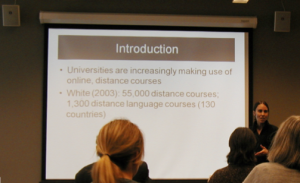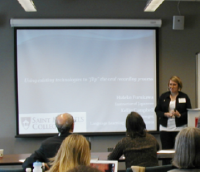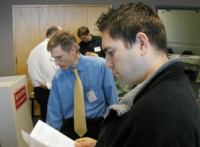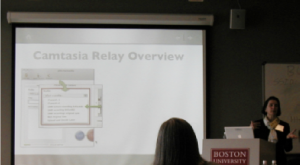Conference Review
 Monday, May 24, 2010 at 2:31PM
Monday, May 24, 2010 at 2:31PM by Dick House
NERALLT Spring 2010
Boston University
The promised rain did arrive in Boston on April 16th, but was far more like a drizzle much of the time. In fact, even the drizzle took a break once in a while. Since the NERALLT Conference was held in a 9th floor space, the participants were allowed some rather striking views of Boston in between the showers.
Those attending also gained some striking views of the variety of ways in which Language Faculty and Instructional Technology practitioners have been learning to “make do” in a way that often seems an improvement over dedicated software and hardware approaches. (The Schedule, with titles and participants, is repeated at the end of this overview.) Even more striking than the teaching and technology innovations was the highly concise and informative nature of the presentations.
Rebekha Abbuhl, from UC Long Beach (a satellite  enclave of “New England,” it appears) led off with a very well articulated explanation of how a distance-learning approach to the need for one-on-one English Composition tutoring might be addressed. Her elucidation of how “Elluminate” software
enclave of “New England,” it appears) led off with a very well articulated explanation of how a distance-learning approach to the need for one-on-one English Composition tutoring might be addressed. Her elucidation of how “Elluminate” software
 Kellie Campbell and Hideko Furukawa, from Saint Michael’s College, outlined another sort of “shoestring approach.” Kellie surveyed the various pieces of grant and pilot project
Kellie Campbell and Hideko Furukawa, from Saint Michael’s College, outlined another sort of “shoestring approach.” Kellie surveyed the various pieces of grant and pilot project equipment sitting on her shelves which were now being lightly used and asked Hideko, a Japanese Instructor, if the Japanese classes might benefit from (specifically) the Flip
cameras which were available. Based on Hideko’s learning goals, they were able to arrive at a number of uses. These included dialog recording, as well as “audio exams” which might be done unsupervised, since the video of the FLIP cameras captured what the students were actually doing during the sessions. The substantial impact of this relatively inexpensive technology on the overall course sequence was evident from Hideko’s carefully thought out evaluation of the cameras in her teaching.
equipment sitting on her shelves which were now being lightly used and asked Hideko, a Japanese Instructor, if the Japanese classes might benefit from (specifically) the Flip
cameras which were available. Based on Hideko’s learning goals, they were able to arrive at a number of uses. These included dialog recording, as well as “audio exams” which might be done unsupervised, since the video of the FLIP cameras captured what the students were actually doing during the sessions. The substantial impact of this relatively inexpensive technology on the overall course sequence was evident from Hideko’s carefully thought out evaluation of the cameras in her teaching.
Aneka Meier, of East Stroudsburg University of Pennsylvania, described how the social networking site NING has contributed to the rejuvenation of a languishing German Program. The very sense of community which a site like NING engenders has proved to be just what Aneka needed to create a sense of shared interest within and among her classes. Interestingly, though NING is similar in nature to FaceBook, it is seen by her students as separate, thus not giving students the sense that academia has “invaded” their social world. Though the first portion of this session, in which Aneka outlined the sociology and technology behind using Web 2.0 in the classroom, may have seemed somewhat unnecessary to the particular group gathered at Boston University, it nonetheless provided an extremely well articulated “white paper” for why educators might consider these approaches. The only downside to this presentation was the news from the audience that NING is in the process of becoming a “for pay” site.
The three Poster Sessions each had their own message.
 Audrey Sartiaux, of Union College, provided a very useful overview of the use of audio and other media freeware, combined with “Voicethread,” a very innovative media-driven social networking site, might be leveraged to create real oral-aural interaction among students. Being able to hear of some of the quirks of these free offerings was as useful as the conceptual framework provided.
Audrey Sartiaux, of Union College, provided a very useful overview of the use of audio and other media freeware, combined with “Voicethread,” a very innovative media-driven social networking site, might be leveraged to create real oral-aural interaction among students. Being able to hear of some of the quirks of these free offerings was as useful as the conceptual framework provided.
 Thomas Hammond, of Harvard University, and Gordon Stewart, of Princeton University, provided a thought provoking snapshot of their work on a prototype tool (VGen) which uses a programming approach to discovering which words in a text might need to be glossed for readers learning a language. The fact that VGen is “agnostic” as to the actual language used in its word counts makes it plausible to consider applying it to Foreign Language Sources. Further, the base texts used for comparison may be any text available (such as the Gutenberg site).
Thomas Hammond, of Harvard University, and Gordon Stewart, of Princeton University, provided a thought provoking snapshot of their work on a prototype tool (VGen) which uses a programming approach to discovering which words in a text might need to be glossed for readers learning a language. The fact that VGen is “agnostic” as to the actual language used in its word counts makes it plausible to consider applying it to Foreign Language Sources. Further, the base texts used for comparison may be any text available (such as the Gutenberg site).
 Luke McCarthy, of Norwalk Community College, demonstrated ways in which online audio and video might be incorporated into “homemade” exercises which can fulfill the same rôles as the exercises that the expensive, password protected publishers’ sites provide. He provided material, including a CD that participants might take away for experimentation.
Luke McCarthy, of Norwalk Community College, demonstrated ways in which online audio and video might be incorporated into “homemade” exercises which can fulfill the same rôles as the exercises that the expensive, password protected publishers’ sites provide. He provided material, including a CD that participants might take away for experimentation.
Following the poster sessions, Eduardo Lage-Otero, of Trinity College, provided a broad range of observations on his institution’s transition from Blackboard to Moodle, along the way mentioning the challenges of integrating NanoGong (text and audio) and Kaltura (video) open source applications. The issue of on-campus technical expertise versus “for profit” pre-packaged solutions was evident, but, for those with the time and energy to experiment, it may be possible for an institution or Language Resource Center to provide rich opportunities for relatively little money.
 Mary Simone, of UMass Boston, presented the pros and cons of using iTunesU to deliver audio, video, and even text files for course content. Of particular note was the difficulty in coordinating a password protected environment for UMass students. (iTunesU is often used as a public, “PR” sort of presence by colleges and universities.) At the moment, this process is very time intensive for staff, since usernames have to be registered more-or-less manually. The particular video format needed for iTunesU has also required file conversions.
Mary Simone, of UMass Boston, presented the pros and cons of using iTunesU to deliver audio, video, and even text files for course content. Of particular note was the difficulty in coordinating a password protected environment for UMass students. (iTunesU is often used as a public, “PR” sort of presence by colleges and universities.) At the moment, this process is very time intensive for staff, since usernames have to be registered more-or-less manually. The particular video format needed for iTunesU has also required file conversions.
In addition, the issue of copyright has loomed large, and UMass has spent a good bit of time creating a policy. Interestingly enough, SCOLA has allowed for converting video content and reposting it through iTunesU. The NERALLT audience was left with the impression that this approach, while useful to UMass Boston, might be a good fit only for those institutions with a particular sort of departmental infrastructure (both bureaucratic and technical). Camtasia Relay was discussed as a means of recording classroom lectures for on-demand viewing later by students. Mention was made of faculty concerns about class attendance if students “didn’t have to attend” to get content. The video indexing site wwitv.com was also discussed as a means of linking to course videos.
Program Synopsis
Rebekha Abbuhl, Ph.D., California State University at Long Beach - Meeting Student Needs on a Budget: Preparing Teachers to Provide Online Instruction Using Low-cost Resources (Elluminate)
Hideko Furukawa, Kellie Campbell, Saint Michael's College - Using Existing Technologies to “Flip” the Oral Recording Process (Flip Camera)
Aneka C. Meier, Ph.D., East Stroudsburg University of Pennsylvania - Social Networking: Enhancing Standards-based Foreign Language and Culture Learning via the Online Application Platform Ning
Audrey Sartiaux, Ph.D., Union College - Captivating Stories: How to Create Budget Friendly Digital Narratives
Thomas Hammond, Harvard University, Gordon Stewart, Princeton University - VGen: Using Information Retrieval to Predict Learners’ Lexical Challenges
Eduardo Lage-Otero, Ph. D.,Trinity College - Freedom of Speech: Open-source Voice Tools in Moodle
Mary Simone, UMass Amherst - iTunesU and SCOLA
